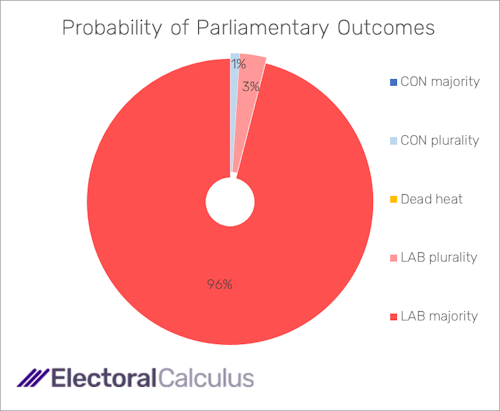If the Reform Party holds its twelve percent support, it won't win any seats at the forthcoming general election. However, because nine-tenths of Reform support is drawn from former Conservative voters, this will deliver more than 100 Tory seats to the Labour Party.
The current halving of Tory support from 2019 is principally due to defections to Reform rather than a switch to Labour, according to YouGov. For every ex-Tory who reports switching to Labour almost three report moving further to the right to endorse Reform. If this rate of defection is maintained at the general election, the Tories will win only 90 seats, their worst showing ever.

Thanks to Reform, the Labour Party is currently projected to win 459 seats under Sir Keir Starmer's leadership, substantially more than Tony Blair garnered for Labour in 1997. Its support has risen by 10 percentage points thanks to the post-Corbyn party picking up support from first-time voters, about one-third of former Liberal Democrats and one-eighth of Tories. This is sufficient to give it an absolute majority in the House of Commons without any gaining additional seats thanks to Reform.
The Liberal Democrats also stand to gain greatly from the impact of Reform in the blue wall seats where Liberals are in second place. Electoral Calculus projects the Lib Dems taking 49 seats, more than double the likely number they would win without the impact of Reform.
Rishi Sunak has two options to regain Conservative seats. The easier target is the fifth of electors who don't know how they will vote but voted Conservative at the last election. Were he to regain the support of all of these uncertain electors, this would reduce the current Labour national lead to about 10 percent. However, this would only bring the Conservatives up to about 175 seats and Labour would win control of government.
The alternative for Sunak is to win back support from people who now say they will vote Reform. He is now attempting this with hard-right policies on such issues as immigration. If Sunak managed to regain half of Reform's 12 percent of supporters, the number of Conservative seats would rise to about 160. If Reform were to collapse and all its current supporters voted Tory, it would end up with about 225 MPs. Such a recovery would still leave Labour in government with a big enough majority to last to 2029.
There is always the possibility that Reform's support could increase, especially if Nigel Farage jumped on the Reform bandwagon. If Conservative defections added another 3 percent, it would still have difficulty winning any MPs but the Conservatives would fall to less than 60 MPs. If Reform were to rise to 18 percent, it would have more support than the Conservatives, but the Tories would have the bitter consolation of having 31 seats against one for Reform.
In principle Sunak could try to have it both ways, winning back both don't knows and defectors to Reform. But such a strategy risks falling between two stools, pushing moderate don't knows to stay home or vote for the Liberal Democrats or Labour, and lacking the firm conviction that the Reform Party offers.
Electoral Calculus is currently forecasting a 99 percent likelihood of Labour winning the most seats. Thus, the realistic but unappealing goal for Sunak is how to reduce the size of the Conservative defeat.
Richard Rose is Britain's senior psephologist and an expert on party government. His most recent book Welfare Goes Global is published by OUP.